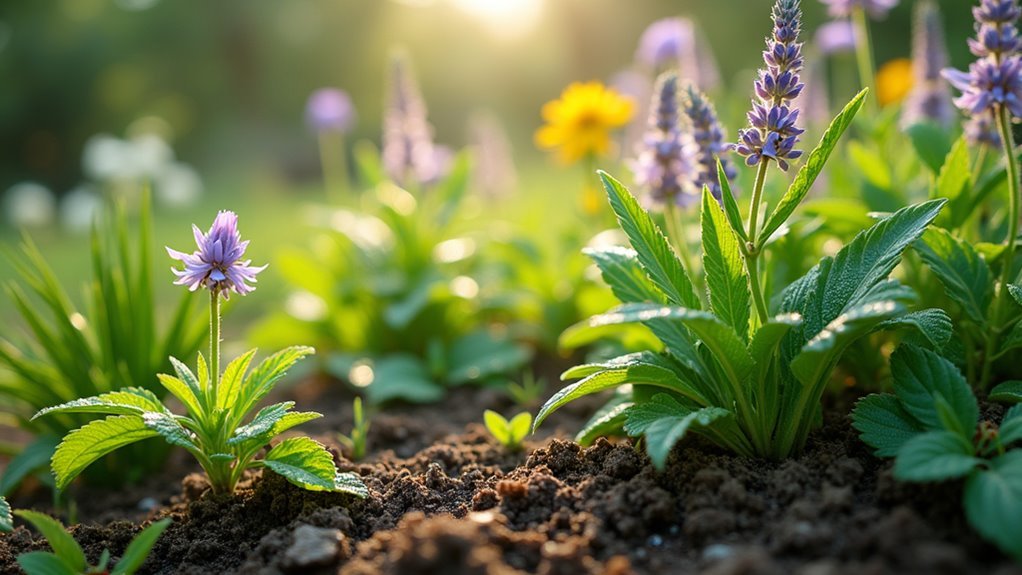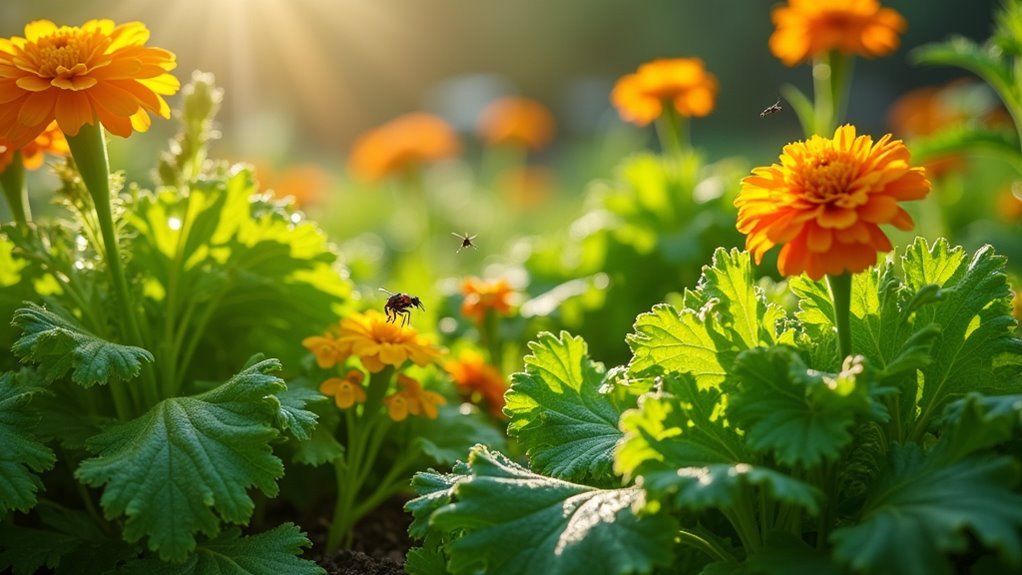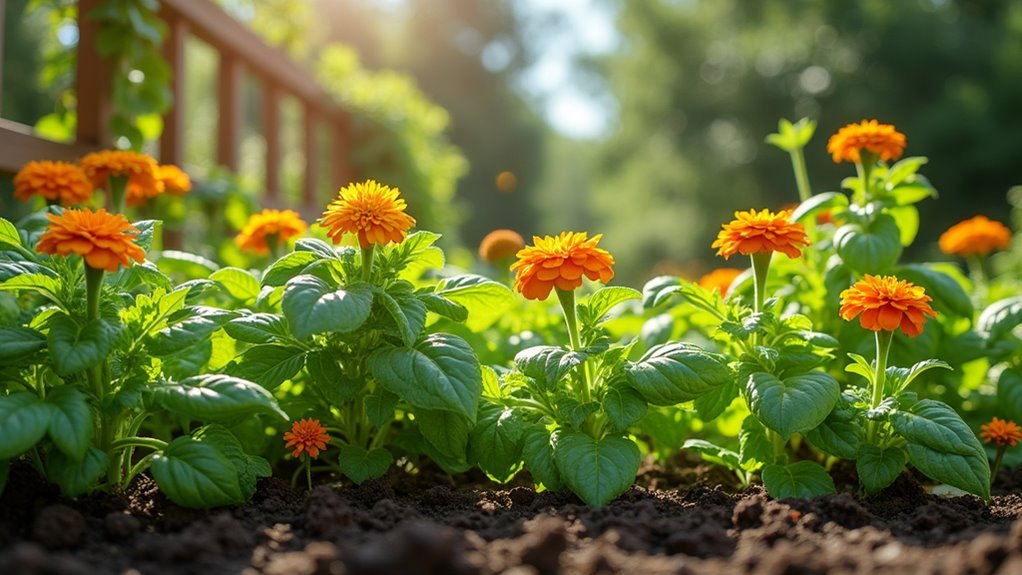Companion plants repel garden pests through natural chemical warfare, releasing volatile organic compounds and strong fragrances that confuse insects’ navigation systems. These aromatic herbs mask your crops’ appealing scents, scrambling pests’ ability to detect their target plants and follow chemical trails. Plants like basil, marigolds, and alliums emit specific compounds that deter aphids, nematodes, and beetles while attracting beneficial predators. This creates a protective barrier that can reduce pest attraction by up to 50%, establishing a self-regulating ecosystem that’ll transform your garden’s defenses.
The Science Behind Natural Pest Deterrence in Plants

While chemical pesticides dominate modern agriculture, nature has developed its own sophisticated defense systems that you can harness in your garden.
When you implement companion planting, you’re utilizing plants’ natural chemical warfare against pests. These botanical allies produce specific compounds that actively repel pests through multiple mechanisms.
Strong fragrances from companion plants mask your vegetables’ scents, confusing insects searching for food sources.
Plants like marigolds release toxic chemicals that eliminate soil-dwelling nematodes, while herbs containing essential oils create protective barriers around vulnerable crops.
Additionally, flowering companions attract beneficial insects such as ladybugs and parasitic wasps, establishing natural predator-prey relationships in your garden ecosystem.
This biological approach creates a self-sustaining defense network that protects your plants without synthetic chemicals.
How Strong Fragrances Confuse and Repel Garden Pests
When you plant strong-scented companions throughout your garden, you’re fundamentally creating a natural smokescreen that masks the appealing aromas of your main crops.
These potent fragrances overwhelm pests’ sensitive detection systems, making it nearly impossible for them to navigate toward their preferred host plants.
You’ll find that herbs like mint, basil, and garlic work particularly well because their intense scents scramble the chemical signals that guide insects to their targets.
Masking Host Plant Scents
Anyone who’s walked through a garden filled with herbs knows how powerfully fragrant plants can transform the air around them.
When you plant aromatic herbs like basil and mint alongside your vegetables, you’re creating a natural defense system that excels at masking host plant scents. These fragrant companions release volatile compounds that overwhelm pests’ sensory perception, making it nearly impossible for them to detect their preferred food sources.
Your garden becomes a confusing maze of competing scents when you strategically place these aromatic plants.
Research demonstrates this technique can reduce pest attraction by up to 50%, effectively repelling pests through sensory interference. By masking the specific odors that draw harmful insects to your crops, you’re disrupting their navigation system and protecting your harvest naturally.
Disrupting Pest Navigation Systems
Beyond masking scents, aromatic companion plants actively scramble the sophisticated navigation systems that pests rely on to find their targets.
When you plant mint, lavender, basil, and rosemary throughout your garden, their strong fragrances create a confusing sensory landscape that disrupts pest behavior. These potent scents interfere with insects’ ability to follow chemical trails and locate their preferred host plants.
The aromatic compounds also disrupt pheromone communication between pests, preventing them from attracting mates or coordinating attacks on your crops.
- Chemical Interference: Strong fragrances block pest receptors from detecting host plant signals
- Pheromone Disruption: Aromatic plants prevent pest mating and danger communication
- Sensory Overload: Multiple fragrant plants create overwhelming confusion for garden invaders
- Navigation Scrambling: Pests lose directional ability in heavily scented environments
- Target Concealment: Host plants become invisible within aromatic plant communities
Trap Cropping: Using Decoy Plants to Protect Your Vegetables

While pests inevitably find their way into every garden, you can outsmart them using trap cropping—a clever strategy that turns their natural instincts against them.
Unlike plants that repel pests, trap crops act as irresistible decoys, drawing harmful insects away from your valuable vegetables. You’ll plant specific “sacrificial” plants that pests prefer over your main crops.
Nasturtiums excel at luring aphids from tomatoes and peppers, while radishes attract cabbage root maggots away from brassicas. Eggplants effectively draw Colorado potato beetles from potatoes.
Position these trap crops along garden borders to intercept pests early. This concentrated approach simplifies pest management since you’ll know exactly where to find them.
Additionally, some trap crops attract beneficial insects that further enhance your garden’s natural defense system.
Chemical Compounds That Make Plants Natural Pesticides
You’ll discover that plants have evolved sophisticated chemical defense systems that actively ward off pests through naturally produced compounds.
These volatile organic compounds and specialized molecules work as your garden’s built-in pesticide factory, targeting specific pests without harming beneficial insects.
Understanding how plants manufacture and deploy their chemical arsenal will help you select the most effective companion plants for your specific pest problems.
Natural Pest Defense Mechanisms
When you’re looking to harness nature’s own pest control system, understanding how plants produce chemical compounds that act as natural pesticides can transform your gardening strategy.
These defense mechanisms work through several key approaches that’ll help you create an effective organic gardening system.
Plants have evolved sophisticated ways to repel pests naturally. Basil releases VOCs that deter aphids, while marigolds produce thiophene compounds targeting soil nematodes.
Alliums create sulfur-based odors that beetles and aphids avoid, and tansy generates pyrethrin-like compounds for broad-spectrum natural pest control.
- VOC emission creates invisible protective barriers around vulnerable plants
- Root-zone compounds prevent soil-dwelling pests from establishing colonies
- Aromatic sulfur compounds mask attractive scents from target crops
- Natural pyrethrin production offers contact-kill properties against insects
- Multi-functional compounds simultaneously attract beneficial predators while deterring harmful pests
Volatile Compound Production Systems
Behind every thriving companion planting system lies a complex network of volatile organic compounds that plants deploy as their primary chemical defense arsenal.
These volatile compound production systems work by releasing specific chemicals that repel pests through scent interference and behavioral disruption.
When you plant basil, it releases eugenol that confuses mosquitoes and flies while attracting beneficial pollinators.
Mint and rosemary’s aromatic compounds disrupt pest feeding patterns, protecting nearby vulnerable crops.
Marigolds produce thiophenes that target soil-dwelling nematodes, creating healthier growing conditions.
You’ll find these natural pesticide systems mask the scent signatures of host plants, making it difficult for herbivorous insects to locate their preferred targets.
This chemical camouflage effectively shields your garden from infestations without synthetic interventions.
Plant Chemical Arsenal Types
Plants manufacture distinct categories of chemical weapons, each targeting different pest vulnerabilities through specialized molecular structures.
When you understand these natural pesticides, you’ll see how plants produce sophisticated defense mechanisms that work better than synthetic alternatives.
Terpenes and alkaloids create strong odors that mask crop scents and directly repel pests. Essential oils in mint and rosemary disrupt insect sensory systems, preventing them from finding host plants.
Allelopathic chemicals released into soil inhibit weed growth while protecting vulnerable crops. These compounds don’t just repel pests—they actively attract beneficial insects like predatory wasps and ladybugs for biological control.
- Terpenes: Aromatic compounds that confuse pest navigation systems
- Alkaloids: Bitter toxins that deter feeding behavior
- Essential oils: Sensory disruptors targeting insect perception
- Allelopathic chemicals: Soil-based growth inhibitors
- Volatile organic compounds: Beneficial insect attractants
Creating Beneficial Insect Habitats to Control Harmful Pests
Since harmful pests can quickly overwhelm garden crops, you’ll want to establish habitats that attract and sustain beneficial insects as your first line of defense.
Creating diverse flowering environments encourages predatory species that naturally control pest populations through effective pest management strategies.
Diverse flowering gardens naturally encourage beneficial predatory insects that effectively control harmful pest populations without chemical interventions.
Companion planting with herbs like dill and fennel attracts ladybugs and parasitic wasps, which target aphids and other destructive insects.
Native flowering plants such as cosmos and alyssum provide essential nectar and pollen sources for beneficial insects.
You can also implement trap crops like nasturtiums to divert pests away from valuable plants while simultaneously attracting helpful predators.
Maintaining plant variety enhances biodiversity and creates balanced ecosystems where beneficial insects thrive, establishing sustainable natural pest control systems.
Plant Diversity as a Defense Against Pest Infestations

While monoculture gardens create easy targets for specialized pests, diversifying your plantings transforms your garden into a natural fortress that confuses and deters harmful insects.
Plant diversity disrupts pest detection patterns, making it harder for them to locate their preferred host plants. Companion planting with fragrant herbs and flowers masks vulnerable crops’ scents, creating an effective barrier against infestations.
Your diverse garden ecosystem naturally supports beneficial predators that control harmful pest populations. This polyculture approach has proven considerably more effective than single-crop systems for pest control.
- Mix vegetables with strongly scented herbs like basil and rosemary
- Interplant flowers throughout vegetable beds to attract beneficial insects
- Rotate crop families seasonally to break pest life cycles
- Create habitat corridors for predatory insects
- Combine early and late-season plants for continuous ecosystem support
Specific Companion Plant Combinations That Target Common Garden Pests
Once you understand how plant diversity creates natural pest barriers, you can implement specific companion combinations that target your garden’s most troublesome invaders.
Basil serves as an excellent companion for tomatoes, effectively helping repel tomato hornworms that can devastate your crop.
Plant basil alongside your tomatoes to create a natural defense system against destructive hornworms in your garden.
When you interplant marigolds with zucchini, you’ll greatly reduce squash bug populations threatening your plants.
Nasturtiums work brilliantly as trap crops, drawing aphids away from valuable vegetables.
Rosemary’s potent scent naturally deters cabbage moths, making it perfect alongside broccoli and cruciferous crops.
Dill attracts beneficial ladybugs that hunt aphids, creating natural pest control.
These strategic companion plantings transform your garden into a self-defending ecosystem where plants actively protect each other from common pests.
Building a Balanced Garden Ecosystem Through Strategic Plant Partnerships
When you strategically pair plants that naturally support each other, you’re creating a self-sustaining garden ecosystem that actively fights pests while promoting healthy growth.
Through companion planting, you’ll develop natural pest control systems that reduce your dependence on chemical interventions.
Diverse plant combinations confuse harmful insects with varied scents and visual signals, making it harder for them to locate target crops. Aromatic herbs like basil and mint release fragrances that repel specific pests while attracting beneficial insects that hunt down garden destroyers.
Trap crops such as nasturtiums draw pests away from your valuable plants, protecting your harvest.
- Plant diversity disrupts pest feeding and breeding patterns
- Beneficial insects establish permanent colonies when habitat needs are met
- Natural pest predators replace chemical pesticide dependency
- Strategic partnerships create multiple defense layers against garden threats
- Self-regulating ecosystems maintain long-term garden health
Frequently Asked Questions
How Does Companion Planting Repel Pests?
You’ll find companion planting repels pests through strong fragrances from herbs, diverse scents that confuse insects, trap crops that lure pests away, and beneficial compounds that create healthier garden ecosystems.
Which Companion Plant Repels Flies and Ants?
You’ll want to plant mint as your go-to companion plant since it repels both flies and ants effectively. Mint’s strong scent disrupts ant trails while creating an environment that flies can’t tolerate.
What Plants Repel Insects in Gardens?
You’ll find marigolds, basil, mint, garlic, chives, nasturtiums, lavender, and rosemary effectively repel garden insects. They release strong fragrances and sulfur compounds that deter aphids, hornworms, cabbage moths, mosquitoes, and nematodes naturally.
What Are the Best Companion Plants for Beneficial Insects?
You’ll want to plant marigolds, dill, fennel, parsley, sweet alyssum, borage, zinnias, and cosmos. These companions attract ladybugs, lacewings, parasitic wasps, and hoverflies that’ll control pests while supporting garden biodiversity.
In Summary
By understanding these natural mechanisms, you’re equipped to create a thriving garden ecosystem that works with nature instead of against it. You’ll find that strategic companion planting doesn’t just repel pests—it enhances soil health, supports beneficial insects, and increases your overall harvest. Start with simple combinations like basil with tomatoes or marigolds throughout your beds, and you’ll quickly see the powerful results of plant partnerships in action.





Leave a Reply